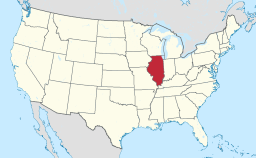Waterloo, Illinois
| Waterloo | |
| City | |
| Name origin: Battle of Waterloo | |
| Motto: City Conveniences, Rural Advantages | |
| Country | United States |
|---|---|
| State | Illinois |
| County | Monroe |
| Precincts | 16, 17, 18, 19, 26, and 27 |
| Elevation | 717 ft (219 m) |
| Coordinates | 38°20′7″N 90°9′10″W / 38.33528°N 90.15278°WCoordinates: 38°20′7″N 90°9′10″W / 38.33528°N 90.15278°W |
| Area | 7.66 sq mi (20 km2) |
| - land | 7.52 sq mi (19 km2) |
| - water | 0.14 sq mi (0 km2) |
| Population | 9,811 (2010) |
| Density | 1,304.6/sq mi (504/km2) |
| Founded | 1818 |
| - Chartered as town | 1849 |
| - Incorporation | 1889 |
| Mayor | Tom Smith |
| Timezone | CST (UTC-6) |
| - summer (DST) | CDT (UTC-5) |
| Postal code | 62298 |
| Area code | 618 |
|
Location in Monroe County and the state of Illinois.
|
|
|
Location of Illinois in the United States
|
|
| Website: http://www.waterloo.il.us | |
Waterloo is a city in Monroe County, Illinois, United States. The population was 9,811 at the 2010 census. It is the county seat of Monroe County.
Waterloo is located at 38°20′7″N 90°9′10″W / 38.33528°N 90.15278°W (38.335243, -90.152685).
According to the 2010 census, Waterloo has a total area of 7.66 square miles (19.84 km2), of which 7.52 square miles (19.48 km2) (or 98.17%) is land and 0.14 square miles (0.36 km2) (or 1.83%) is water.Illinois Route 3 and Illinois Route 156 intersect within its bounds, and it is along the historic trail from Kaskaskia to St. Louis.
Waterloo's history dates back to the 18th century, with the French being the first Europeans to settle in the area. The site was ideal because of its elevation; the proximity of the Mississippi River Valley brought frequent flooding to the lowlands. It was also close to Fort de Chartres, a French stronghold. They named their settlement Bellefontaine, meaning 'beautiful spring.' This name related to a spring of water a mile south of the site of Waterloo, a frequent campsite on journeys between Kaskaskia, Cahokia, and St. Louis. France had long since abandoned the area, as it had been ceded to Britain in the wake of the Seven Years' War in 1763 and had since been unoccupied.
James Moore and many of the settlers that followed him had been soldiers in George Rogers Clark's Illinois campaign of 1778. They named their settlement Bellefontaine, meaning 'beautiful spring.' This name related to a spring of water a mile south of the present-day site of Waterloo, a frequent campsite on journeys between Kaskaskia, Cahokia, and St. Louis. The first documented English-speakers came, in the spring of 1782, when James Moore, Larken Rutherford, and James Garretson, of Maryland and Virginia, settled at or near Bellefontaine. Upon their arrival, they were the first permanent English-speakers, in the entire Northwest Territory. Moore established himself at the site of the namesake spring, and the tract remained in possession of the Moore family for over a century. The kitchen of the Bellefontaine House, situated a short distance west of the southern end of Main Street, is believed to be Moore's original log cabin. It was restored and remains as a local landmark.
...
Wikipedia


